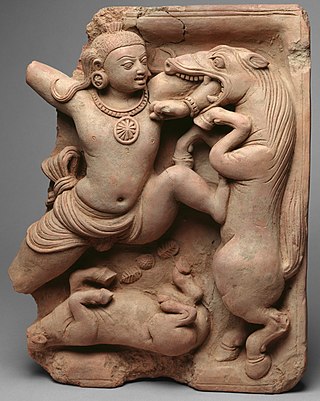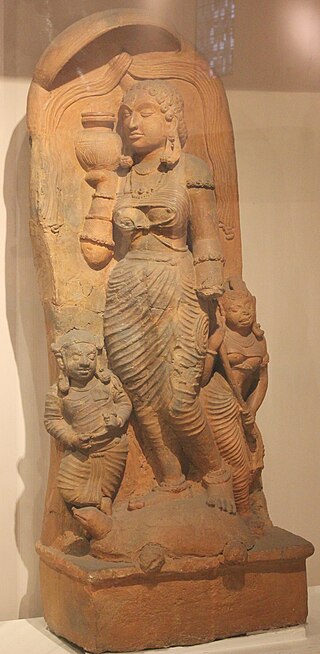Related Research Articles

In Hinduism, Daksha is one of the prajapati, the agents of creation, as well as a divine king-rishi. His iconography depicts him as a man with a stocky body and a handsome face or the head of a goat.

Varaha is an avatar of the Hindu deity Vishnu, in the form of a wild boar. Varaha is generally listed as third in the Dashavatara, the ten principal avatars of Vishnu.

Devaki is a character in Hindu literature, most noted for being the mother of the god Krishna. She is one of the seven daughters of Devapa or Devaka, a king of the Yadu dynasty, and has four brothers. She is one of the wives of Vasudeva. Her cousin is Kamsa, the king of Mathura, a cruel tyrant who had been told by Narada that he had been an asura killed by Vishnu in his previous life (Kalanemi), exacerbating his wickedness. According to popular tradition, Devaki is considered to be an incarnation of Aditi, a mother goddess who was the daughter of Daksha and the wife of Kashyapa.

Rukmini is a Hindu goddess and the first queen and eternal wife of Krishna. In Vaishnava tradition, she is described as Krishna's principal queen in Dvaraka, as well as the chief of his wives. She is an incarnation of the goddess of prosperity, Lakshmi. The goddess is regarded to be the chief or principal consort of Krishna in various pieces of literature and is venerated primarily in Warkari and Haridasa tradition, and additionally in Sri Vaishnavism where Lakshmi-Narayana are revered and worshipped.

Kamadhenu, also known as Surabhi, is a divine bovine-goddess described in Hinduism as the mother of all cows. She is a miraculous cow of plenty who provides her owner whatever he desires and is often portrayed as the mother of other cattle. In iconography, she is generally depicted as a white cow with a female head and breasts, the wings of a bird, and the tail of a peafowl or as a white cow containing various deities within her body. Kamadhenu is not worshipped independently as a goddess. Rather, she is honored by the Hindu veneration of cows, who are regarded as her earthly embodiments.

Sanjna, also known as Saranyu, is a Hindu goddess and the chief consort of Surya, the Sun god. She is mentioned in the Rigveda, and also appears in later Hindu scriptures including the Harivamsa and the Puranas.

The Yadava were an ancient Indian people who believed to be descended from Yadu, a legendary king of Chandravamsha lineage. The community was formed of various clans, being the Abhira, Andhaka, Vrishni, and Satvatas, who all worshipped Krishna. They are listed in ancient Indian literature as the segments of the lineage of Yadu (Yaduvamsha). At various times there have been a number of communities and royal dynasties of the Indian subcontinent that have claimed descent from the ancient Yadava clans and legendary Yadava personalities, thus describing themselves as the Yadavas. The Yadavas of the Mahabharata period were known to be the followers of Vaishnavism, of which Krishna was the leader: they were Gopas (cowherd) by profession, but at the same time they held the status of the Kshatriyas, participating in the battle of Kurukshetra. The present Ahirs are also followers of Vaisnavism.

Satyabhama, also known as Satrajiti, is a Hindu goddess and the third queen-consort of the Hindu god Krishna. Satyabhama is described as the incarnation of Bhudevi, the goddess and the personification of the earth. She aided Krishna in defeating the asura Narakasura.

The Kumaras are four sages (rishis) from the Puranic texts of Hinduism who roam the universe as children, generally named Sanaka, Sanandana, Sanatana, and Sanatkumara. They are described as the first mind-born creations and sons of the creator-god Brahma. Born from Brahma's mind, the four Kumaras undertook lifelong vows of celibacy (brahmacharya) against the wishes of their father. They are said to wander throughout the materialistic and spiritualistic universe without any desire but with purpose to teach. All four brothers studied Vedas from their childhood, and always travelled together.

In Hindu mythology, Keshi is the horse-demon, killed by Krishna, an avatar of the god Vishnu. The demon was dispatched by Krishna's evil uncle Kamsa, who was destined to die at Krishna's hands.

Samba was a son of the Hindu god Krishna and his second consort, Jambavati. His foolish prank brought an end to the Yadu dynasty.

The Ashtabharya or Ashta-bharya(s) is the group of eight principal queen-consorts of Hindu god Krishna, the king of Dvaraka, Saurashtra in the Dvapara Yuga (epoch). The most popular list, found in the Bhagavata Purana, includes: Rukmini, Satyabhama, Jambavati, Kalindi, Mitravinda, Nagnajiti, Bhadra, and Lakshmana. Variations exist in the Vishnu Purana and the Harivamsa, which includes queens called Madri or Rohini, instead of Bhadra. Most of them were princesses.

Yamuna is a sacred river in Hinduism and the main tributary of the Ganges River. The river is also worshipped as a Hindu goddess called Yamuna. Yamuna is known as Yami in early texts, while in later literature, she is called Kalindi. In Hindu scriptures, she is the daughter of Surya, the sun god, and Sanjna, the cloud goddess. She is also the twin sister of Yama, god of death. She is associated with the deity Krishna as one of his eight principal consorts, called the Ashtabharya. Yamuna plays an important role in Krishna's early life as a river. According to Hindu scriptures, bathing in or drinking Yamuna's waters removes sin.

Jambavati is chronologically the second Ashtabharya of the Hindu god Krishna. She is the only daughter of the bear-king Jambavan. Krishna marries her when he defeats her father, Jambavan, in his quest to retrieve the stolen Syamantaka jewel.

Nagnajiti, also known as Satya, and Nappinnai, is the fifth of the Ashtabharya, the eight principal wives of the Hindu god Krishna.

Mitravinda is chronologically the sixth of the Ashtabharya of the Hindu god Krishna, an avatar of the god Vishnu, and the king of Dvaraka in the Dvapara Yuga (epoch).

Bhadra is one of the Ashtabharya, the eight principal queen-consorts of Hindu god Krishna, according to the scripture Bhagavata Purana. The Bhagavata Purana regards her as being the eighth wife of Krishna; sometimes she is described as the seventh wife. The Vishnu Purana and the Harivamsa do not name Bhadra at all in the list of the Ashtabharya, but refer to her as 'the daughter of Dhrishtaketu' or 'the princess of Kekeya'.

Lakshmana or Lakshana is the seventh of the Ashtabharya, the eight principal queen-consorts of Hindu god Krishna, an avatar of the god Vishnu and the king of Dvaraka in the Dvapara Yuga (epoch).
Besides eight principal queens (Ashtabharya), the Hindu god Krishna, an avatar of the god Vishnu and the king of Dvaraka, wedded a number of captured women, whose number is mentioned as 16,000 or 16,108 in different scriptures.
Kalmashapada, also known as Saudasa, Mitrasaha, and Amitrasaha is a king of the Ikshvaku dynasty In Hindu scriptures, who was cursed to be a rakshasa (demon) by the sage Vashishtha. He is described as an ancestor of Rama, the avatar of the god Vishnu and the hero of the Hindu epic Ramayana.
References
- 1 2 Horace Hayman Wilson (1870). The Vishńu Puráńa: a system of Hindu mythology and tradition. Trübner. pp. 79-83, 107. Retrieved 20 February 2013.
- ↑ Hopkins, Edward Washburn (1915). Epic mythology. Strassburg K.J. Trübner. p. 13. ISBN 0-8426-0560-6.
- 1 2 Prabhupada. "Bhagavata Purana 10.61.18". Bhaktivedanta Book Trust. Archived from the original on 2014-09-21.
- 1 2 Swami Venkatesananda; Venkatesananda (Swami.) (1989). The Concise Śrīmad Bhāgavataṁ. SUNY Press. pp. 301, 323. ISBN 978-1-4384-2283-1 . Retrieved 2 March 2013.
- ↑ Jagdish Lal Shastri; Arnold Kunst. Ancient Indian tradition & mythology. Motilal Banarsidass. p. 1649. Retrieved 2 March 2013.
- ↑ Kisari Mohan Ganguli. "The Mahabharata, Book 16: Mausala Parva". Sacred-texts.com. Retrieved 18 March 2013.
